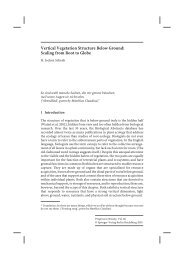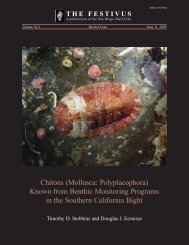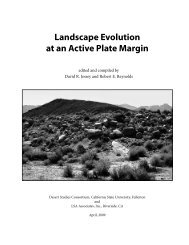LIVE BacLight Bacterial Gram Stain Kit
LIVE BacLight Bacterial Gram Stain Kit
LIVE BacLight Bacterial Gram Stain Kit
Create successful ePaper yourself
Turn your PDF publications into a flip-book with our unique Google optimized e-Paper software.
Molecular Probes’ fluorophore-conjugated WGA derivatives.<br />
Our Via<strong>Gram</strong> Red + <strong>Bacterial</strong> <strong>Gram</strong> <strong>Stain</strong> and Viability <strong>Kit</strong><br />
(V-7023) combines a bacterial viability test and WGA-based<br />
gram-sign determination in a simple, three-color assay.<br />
Care must be taken to remove traces of growth medium<br />
before staining bacteria with the SYTO 9 and hexidium iodide<br />
reagents. Nucleic acids and other media components can bind<br />
these reagents in unpredictable ways, resulting in unacceptable<br />
variations in staining. A single wash step is usually sufficient to<br />
remove significant traces of interfering media components from<br />
the bacterial suspension. Phosphate wash buffers are not recommended<br />
as they appear to decrease the staining efficiency.<br />
Selection of Optical Filters<br />
The fluorescence from both live gram-negative and live grampositive<br />
bacteria may be viewed simultaneously with any standard<br />
fluorescein longpass optical filter set. Alternatively, the live<br />
gram-negative (green fluorescent) and live gram-positive (red<br />
fluorescent) cells may be viewed separately with fluorescein and<br />
Texas Red ® bandpass optical filter sets. A summary of the fluorescence<br />
microscope filter sets recommended for use with the<br />
<strong>LIVE</strong> <strong>BacLight</strong> <strong>Bacterial</strong> <strong>Gram</strong> <strong>Stain</strong> <strong>Kit</strong> is shown in Table 1.<br />
Culture Conditions and Preparation of <strong>Bacterial</strong> Suspensions<br />
1.1 Grow a culture of bacteria to late log phase (usually 10 8 –10 9<br />
bacteria/mL) in an appropriate nutrient medium.<br />
1.2 Add 50 µL of the bacterial culture to 1 mL of filter-sterilized<br />
water in a microcentrifuge tube.<br />
1.3 Concentrate by centrifugation for 5 minutes in a microcentrifuge<br />
at 10,000 × g.<br />
1.4 Remove the supernatant and resuspend the pellet in 1 mL of<br />
filter-sterilized water. Note that the water used should be filtered<br />
through a 0.2 µm poreBsize filter to sterilize and to remove particulate<br />
matter that might interfere with the assay.<br />
Optimization of <strong>Bacterial</strong> <strong>Stain</strong>ing in Suspension<br />
The <strong>LIVE</strong> <strong>BacLight</strong> <strong>Bacterial</strong> <strong>Gram</strong> <strong>Stain</strong> assay may be<br />
optimized for a particular fluorescence microscope by testing<br />
several different proportions of Component A to Component B<br />
in the specific application. The fluorescence of bacteria labeled<br />
with the green-fluorescent nucleic acid stain and those labeled<br />
with the red-fluorescent nucleic acid stain may undergo different<br />
rates of photobleaching, depending on the intensity of the excitation<br />
illumination, which varies considerably between fluorescence<br />
microscopes. Note that compensation for photobleaching<br />
is not as important when using a fluorometer or fluorescence<br />
microplate reader because the excitation illumination is much<br />
less intense. We suggest beginning with a 1:1 mixture of Component<br />
A and Component B as described below, observing the<br />
results and subsequently adjusting the mixture for optimum performance.<br />
A 1:1 component mixture results in the same final<br />
concentration of dyes. When used at the recommended dilutions,<br />
the reagent mixes will contribute 0.3% DMSO to the staining solution.<br />
Higher DMSO concentrations may adversely affect staining.<br />
2.1 Combine equal volumes of Component A and Component B<br />
in a microfuge tube and mix thoroughly.<br />
2.2 Add 3 µL of the dye mixture per mL of bacterial suspension.<br />
2.3 Mix thoroughly and incubate at room temperature in the dark<br />
for 15 minutes.<br />
2.4 Trap 5 µL of each stained bacterial suspension between a<br />
slide and an 18 mm square coverslip.<br />
2.5 Observe in a fluorescence microscope equipped with any of<br />
the filter sets listed in Table 1. Live gram-negative organisms<br />
should fluoresce green and gram-positive bacteria should fluoresce<br />
red (see Note).<br />
2.6 To optimize the staining pattern, repeat steps 2.1 through<br />
2.5 with different mixtures of Component A and Component B.<br />
The volume of the dye mixture added to the cell suspension in<br />
step 2.2 may also be varied; however, adding more than 3 µL of<br />
DMSO (from the dye mixture) per mL of bacterial suspension<br />
may adversely affect staining.<br />
<strong>Stain</strong>ing Bacteria Immobilized on Glass Surfaces<br />
3.1 Prepare 1 mL of a 0.1 mg/mL solution of >100,000 MW<br />
poly-L-lysine in water that has been filtered through a 0.2 µm<br />
pore–size filter to sterilize and to remove particulate matter.<br />
Table 1. Characteristics of common filters suitable for use with the <strong>LIVE</strong> <strong>BacLight</strong> <strong>Bacterial</strong> <strong>Gram</strong> <strong>Stain</strong> <strong>Kit</strong>.<br />
Omega filters * Chroma filters * Notes<br />
XF25, XF26, XF115 11001, 41012, 71010<br />
Longpass and dual emission filters useful for simultaneous viewing of SYTO 9 and<br />
hexidium iodide stains<br />
XF22, XF23 31001, 41001 Bandpass filters for viewing SYTO 9 alone<br />
XF32, XF43<br />
XF102, XF108<br />
31002, 31004<br />
41002, 41004<br />
Bandpass filters for viewing hexidium iodide alone<br />
* Catalog numbers for recommended bandpass filter sets for fluorescence microscopy. Omega ® filters are supplied by Omega Optical Inc. (www.omegafilters.com).<br />
Chroma filters are supplied by Chroma Technology Corp. (www.chroma.com).<br />
2<br />
<strong>LIVE</strong> <strong>BacLight</strong> <strong>Bacterial</strong> <strong>Gram</strong> <strong>Stain</strong> <strong>Kit</strong>s
















